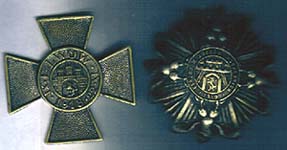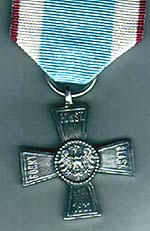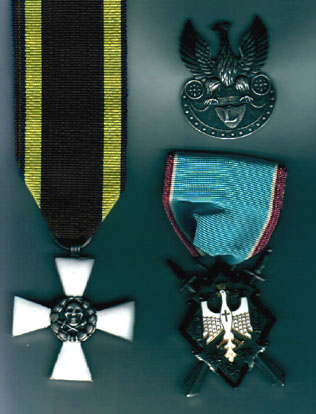The
Polish-Russian War and the Fight for Polish Independence, 1918-1921.
A brief overview by A. Mongeon.
Also known as the Russo-Polish War of 1920.
Between 1918 and 1921 Poland had to fight to re-establish itself as
a nation. The most dangerous enemy that Poland faced at the time
was Bolshevik Russia, under Lenin. At the very least Lenin wanted
to recapture Poland and other lands (Latvia, Lithuania, Estonia, Bialy-Russia
and Ukraine) lost as a result of Czarist Russia's defeat by Germany in
WW I. It is now widely believed that Lenin wanted to expand his Bolshevik
empire beyond the former Russian boundries, using the Red Army as a tool
to accomplish a wider Revolution. Germany and France were War weary
and were experiencing problems such as un-employment and general economic
disruption. Lenin already had political agitators in those countries,
but in order for his Revolution to succeed he would need the presence of
a military force, the Red Army. It became apparent that Lenin was
begining to win the Civil War in Russia and would soon be able to free
up the Red Army for use in Europe. In a pre-emptive strike intended
to stop the Bolsheviks, Jozef Pilsudski, the commander of Polish
Forces, attacked the Bolsheviks in force in February 1919. Pilsudski
could not allow the Bolsheviks to gain full strength. Pilsudski was
hoping that the White and Red forces in Russia would weaken each other
to the point that neither were a threat. Pilsudski also hoped that
other countries (namely Bialy-Russia, Ukraine and the Baltic States) would
form a defensive alliance with Poland against Russia (Red or White).
The alliance never materialized. The War expanded and reached a critical
moment in August, 1920, at the Battle of Warsaw, when the fate of Europe
was decided. This War, and the important events surrounding it, are
virtually absent from most history books. This is surprising given
the huge impact on Europe that would have occured had Poland lost this
War.
Before WW I.
The Polish state became weak in the late 18th century due
to bad leadership, disorganization and the fact that Poland was surrounded
by powerful and better organized enemies. By 1795, the third partition
of Poland was complete. Poland was divided up amongst Russia, Prussia
and Austro-Hungary and would remain occupied until 1918. Polish Patriots
were determined to regain Independence (or at least some rights) and staged
uprisings in 1830, 1844-46, 1848 and 1863. Although these revolts
were crushed, an effective resistance was established and continued to
exist as various "Secret Societies". One of the champions of Independence
was Jozef Pilsudski. Born in 1867, he began underground political
resistance activities in the late 1880's, with the goal of an Independent
Poland at Russia's expense. After being imprisoned in Siberia for
anti-Czarist activities, he escaped and made his way to Austrian Poland
(Galicia). Because Austria was an enemy of Russia, Pilsudski was
permitted to continue his campaign against Russia. Pilsudski gave
valuable intelligence to Austria about Russian positions in Poland and
elsewhere. Pilsudski was able to raise a para-military force in Austria
by 1908, know as the Society (or Riflemen) of TIR. Major locations
of activity included Lwow and Krakow. This force would later form
the basis of the Legions.
During WW I.
Pilsudski placed his Legions under Austrian command in 1914.
They were to fight exclusively against Russia, with the goal of an Independent
post-war Poland. After Russia surrendered in 1917, the Germans
wanted to use the Legions against France. Pilsudski refused to allow
the Legions to be used against France and was imprisoned at Magdeburg for
the remainder of the War. Von Bessler was appointed the head
of the Legions. The Legions disbanded instead of accepting Von Bessler
as leader. In April 1917, only men from the 2nd Brigade
swore an oath to the Germans. Most men of the other Brigades were
imprisoned at places including Szczypiorna, Lomza and (officers) Benjaminow.
Many Legionnaires that were not imprisoned went underground, joining resistance
cells of groups like the POW (Polska Organizacja Wojskowa).

Badge of POW Veterans
Others were assimilated into Austrian (Polish Auxiliary Corps) or German
(Polnische Wehrmacht) units or sent to Germany to work. Yet others
fled to Russia to organize units there.
In early 1918 General Jozef Haller, until this time the Commander
of the 2nd Brigade of Legions, took
some of his troops to Russia after Germany's true motives were revealed
following the implementation of the Brest-Litovsk Treaty.
(Germany, as well as Austro-Hungary had promised a post-war Independent
Poland. The appointment of Von Bessler convinced many Legionnaires
that a post war Poland would be a puppet of Germany, not truly Independent.
Haller was finally convinced that Germany had no intention of granting
Poland her freedom after Germany settled with Russia with no provision
for a Poland of any kind). Haller crossed the front with his followers
at Rarancza in mid February, 1918. Many who tried to cross the front
were captured by the Austrians and were sent to camps in Hungary and Bohemia,
including Huszt, Maramaros and Sziget. The ones that made it through
joined the Polish 2nd Corps in Russia.
Polish units had fought on the Czarist Russian side early in the War,
including the Pulawski Legion.
Many Polish units in Russia, including those that were led by General
Jozef Haller and General Lucjan Zeligowski, eventually went to France
after Russia's surrender. The Polish Army in France (formed
in late 1917-early 1918), made up of many Polish American and Polish Canadian
Volunteers, was a substantial fighting force. This force was to be led
(starting in late 1918) by General Jozef Haller. An earlier attempt
to organize a Polish unit in France (in 1915) was protested by the Russians,
who did not want any Polish nationalistic groups gaining any legitimacy.
After the November 11, 1918 Armistice, much of Haller's Polish Army in
France (known as the Blue Army -the colour of their French Uniforms), made
its way to Poland to assist in the fight for Polish Independence.
When WW I ends, Poland begins the 2nd Republic.
Upon the Armistice with Germany and Austria on November 11, 1918, the
forces of Polish Independence were already in motion. Declarations
were already made before November 11th in Lublin, New York,
Paris and other places. Based on parts of President Wilson's
14 Points Speech (as conditions for Armistice), Poland was to become
an Independent Nation with access to the Baltic Sea. This was later
to be confirmed by the Treaty of Versailles. President Wilson
was made aware of Poland's plight by such activists as Ignacy Paderewski,
who lived in the USA during WW I. Pilsudski was released on November
10, 1918 and went to Warsaw the next day to take command of the Army of
a new Poland.
The Defense of Lwow and the War with the Ukraine 1918-1919.
On October 31st and November 1st, 1918 (almost
2 weeks before the WW I armistice) Ukrainian units (Sich Riflemen)
of the rapidly disintegrating Austrian Army took advantage of the circumstances
and occupied the predominately Polish City of Lwow in Galicia, procaiming
it a part of a Socialist Ukrainian Republic. The citizens of Lwow,
many of them children, fought off the Ukrainians. Polish army units
arrived in a few days to assist the citizens. The fight lasted until
November 22nd, when the Ukrainians were repelled. Many
school children died in this fight and a cemetery in Lwow was created in
their honor. The children are known as Orleta (Eaglets).
The fighting against Ukrainian forces continued until July, 1919 when the
Polish army finally pushed back the Ukrainians (who were weakened by fighting
the Bolsheviks on another front) beyond the Zbrucz River.

Defence of Lwow Cross, Orleta Badge
The Wielkopolski Uprisings against the Germans.
By December 1918, Polish populations in the Polish areas of the former
German Empire began to assert their desire to have these areas declared
as part of Poland. By January, 1919 there was large scale and bitter
fighting against the Germans around Poznan. A peace treaty officially
ended the fighting in February, 1919 with France being the overseer of
the treaty.
The Silesian Uprisings.
Silesia (Slask) was a disputed area under the Treaty of Versailles
and its fate was to be determined by a plebiscite. A multi-national
armed force (France, England, Italy and USA) was sent there during the
voting process to keep order. The vote proved inconclusive. The German
Police authorities in the disputed zone were causing a great deal of friction
by harassing and intimidating Poles in the area. Violence erupted.
Eventually a total of 3 Polish armed uprisings took place, with Wojciech
Korfanty emerging as the leader of the Poles. The Allied Commission
was instrumental in implementing an armistice treaty by June, 1921.
Fighting with the newly formed Czechoslovakian State also occurred, which
resulted in a plebiscite in 1920 over Teschen (Cieszyn). The dispute
flared again when Poland occupied an area around Cieszyn in 1938.

Silesian Cross on Ribbon of Merit.

Upper Silesian Star. Awarded to those who distinguished themselves
during the struggle for Upper Silesia (Un-official decoration). Photo
courtesy of Auctions H.D. Rauch http://www.hdrauch.com/
, used by permission.
Wilno and Central Lithuania and Bialy Russia.
Wilno (Vilnius) and the surrounding area had a high number of
residents of Polish heritage. With the proclamation of Independence
from Russia of the Baltic Republics (Lithuania, Latvia and Estonia) as
well as Bialy-Russia, came fears of the Bolshevik's desire to retake these
areas and install Soviet puppet governments. The initial plan at
the end of WW I was to allow the German army to remain in these areas after
the war in order to protect the region from Bolshevik expansion.
The Germans resented the imposition of the Allies to continue to fight
after the War and consequently had no desire to remain in these areas for
long. As they left, a dangerous "back door" to Poland was created
for the Bolsheviks. Pilsudski hoped that the Baltic States, Bialy-Russia
and the Ukraine would unite with Poland in a defensive alliance against
Russia. This defensive alliance never materialized. Polish
units were formed in the area of Wilno, but were soon overpowered by the
Bolsheviks. The Bolsheviks occupied the area from January 1919 and
proclaimed it a Soviet Republic. In April 1919, Polish units under
General Rydz-Smigly re-occupied the area. The area again fell
into Bolshevik hands in the summer of 1920 and a puppet Soviet government
was installed. Fighting in the area during 1919 and 1920 continued
between Polish forces and the Bolshevik forces, which led to an expanding
front that extended into Bialy-Russia. After the Polish victory at
Warsaw in 1920, the Bolsheviks retreated. A volunteer force mainly
of Poles from Lithuanian and Bialy-Russian regions was formed under General
Lucjan Zeligowski. This force recaptured Wilno and the surrounding
area during October, 1920. A plebiscite was held in 1922, and the
area of Central Lithuania (Litwa Srodkowa) was incorporated into Poland.

Cross of Merit of the Central Lithuanian Army.
The Ukraine, Petlura and General
Bulak-Balachowicz.
In an attempt to help set up a non-Soviet Ukrainian State, Pilsudski
formed an alliance with the Ukrainian Symon Petlura. A combined
force of Poles and Ukrainians made it to Kiev in May, 1920, but
could not hold the area. General Bulak-Balachowicz was originally
from the Wilno area. He was in the Czarist Russian army until the
Bolshevik revolution, when he formed units determined to fight the Bolsheviks.
He became an ally of Pilsudski and organized units of volunteers made up
of Poles from the eastern border areas, which fought in Russia against
the Bolsheviks. One of the terms of the 1921 Riga peace treaty between
Poland and Russia was the removal of official Polish support for any nationalist
groups from Ukraine or Bialy Russia. As a result, Petlura lost Polish
support and was defeated by the Bolsheviks. General Bulak-Balachowicz
remained in Poland after the War. He died in Warsaw in 1940.
He was reputed to have organized a undergroung unit in Warsaw to fight
against the Germans.

Cross of Valour of General Bulak-Balachowicz, WW I Legion Cap Badge,
(General) Haller Swords.
Wolyn and the East
A fighting force comprised of Polish soldiers and local Polish Insurgents
fought in the Ukrainian/ Polish area north of Lwow. Led originally
by Major Leopold Lis-Kula (until his death in 1919), then by Captain
Feliks Jaworowski, this force fought against Ukrainians and later the
Bolsheviks. It later became incorporated into the Polish Army.
The advance of the Red army 1920.
Until the spring of 1920, Poland was pushing or at least holding the
Bolsheviks back. By the summer of 1920 however, the Bolsheviks began
to gain strength as they were winning their civil war in Russia.
By the summer of 1920, the Bolsheviks were advancing into Poland.
It indeed looked as if Poland would be totally defeated. Fearing
a total Bolshevik victory, the Western Allies (most notably France) begged
Pilsudski to accept peace with Lenin, thereby granting Russia much territory
(the Curzon Line). Pilsudski refused, and the Red Army approached
Warsaw by August. Peace overtures made by Lenin were not sincere.
Lenin felt that he had already won the war and would soon be able to continue
the Bolshevik Revolution westward. Pilsudski knew that Lenin could
not be trusted.
The Battle of Warsaw, 1920.
Between the 13th and 16th of August, 1920, a
battle raged in and around Warsaw between Polish and Bolshevik forces.
At stake was the future of Poland as well as the future of Europe.
Red Army commanders made a tactical error when a large part of their force
diverted north of Warsaw in order to cut Polish supply lines from the Baltic
Sea. Pilsudski had set a trap and sprung it, taking full advantage
of the Russian error. The result was the diverted Red Army force
itself became cut off from their supply line, and the remaining Red Army
force was decimated. General Wladyslaw Sikorski commanded
a force (including some French tanks) that defended the city of Warsaw.
This turn in the tide was regarded by many as a miracle, and became known
as the "Miracle on the Wistula". So badly defeated was the Red Army,
that it began a general retreat on all fronts. The Polish forces
pursued the retreating Red Army, defeating them again at the Niemen River
in September. Sikorski had chased the Red army with some armour,
showing that tanks could play a role in rapid advances on the battlefield
(a lesson that Heinz Guderian used later, during WW II). On
October 12, 1920, an Armistice was signed, ending the fighting.
Peace.
With the October 12, 1920 Armistice in Place, it was made official
by the Peace Treaty of Riga, signed on March 18, 1921 and ratified
in Minsk on April 30, 1921, thus ending the Polish-Russian War of 1918-1921,
with the peace to last less than 20 years.

1918-1921 War Medal, awarded to Veterans of the Polish Soviet War.
Stalin's Revenge.
In 1939, Stalin and Hitler agreed to partition Poland between
themselves. A little later than 2 weeks after Hitler invaded Poland
in September, 1939, the Red Army under Stalin invaded the eastern side
of Poland. In Russian controlled Poland any Poles who fought against
the Bolsheviks in the 1918-1921 War were hunted down and executed or sent
to labour camps. The Poles in the German controlled section who fought
in Upper Silesia or the Wielkopolski Uprisings were similarly singled out
by the Germans for reprisals. During and after WW II, an additional
injury was done to the Poles who fought in the 1918-1921 War. The
Soviets tried to erase the 1918-21 War from the history books, especially
the Battle of Warsaw, which was a key event responsible for keeping much
of Europe free of the Communist Revolution. During WW II Stalin tried
to erase every reminder that Poles defeated the Red Army in 1920.
Stalin personally ordered the execution of thousands of Polish Officers
(a majority were veterans of the 1918-21 War), a crime that occured in
1940 at Katyn and other places. The Communists continued the
persecution and murder of Polish Veterans of the 1918-21 War after WW II.
The post-WW II Soviet occupation of Eastern Europe did not inspire Revolution.
The opportunity for Soviet Revolution had been lost in 1920 at Warsaw,
and the taste of Independence that Poland (and other countries) had before
WW II lasted long enough to help inspire the overthrow of the Communist
regimes in Europe by 1990.
References and readings:
Polish Honor and Commemorative Badges 1914-1918 & 1918-1921) by
Wojciech Stela.
White Eagle, Red Star by Norman Davies
Internet sources
Polish Western Border 1918, Professor Cienciala,
University of Kansas:
http://www.ukans.edu/wcb/schools/CLAS/his/aciencia/1/files/newlect11poland.htm
UNIVERSITY OF KANSAS SITE WITH HISTORY OF POLAND
AND EASTERN EUROPE (Chapters 2 - 5 most
relevant) Professor Cienciala:
http://www.ukans.edu/kansas/cienciala/342/342index.html
Haller's Army page:
http://www.geocities.com/hallersarmy/
Defenders of Lwow:
http://www.kresy.co.uk/lwow_eaglets.html
Russo-Polish War 1918-1921 Bibliography:
http://www.york.cuny.edu/~drobnick/russo.html
Jozef Pilsudski Page
http://members.lycos.co.uk/jozefpilsudski/
Back
to the Polish Collector
Back to Polish Medals


